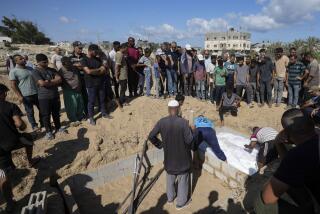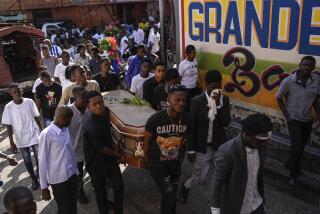Unrelenting Tide of AIDS Erodes Burial Traditions
BRONVILLE TOWNSHIP, South Africa — The mother rises from her deathbed to bury her baby boy. She slumps in a wheelchair borrowed for the occasion, and an elderly relative must help hold her head up so that she can watch the body descend into the red earth.
The casket is heartbreakingly small, and though Evelyn Matule weeps for her child, her eyes are dry. Sickness and despair have stolen her tears.
Alfred is the second boy Matule has lost in a year to a disease also racking her body: AIDS. A toddler’s coffin is mercifully inexpensive, but the earlier death left Matule and her family so strapped that they will serve only butter sandwiches to the few guests.
On one side of the boy’s grave in this township outside the city of Welkom in central South Africa are fresh heaps of loam, each new grave marked with numbered aluminum tags, baby rattles and prescription bottles for remedies that didn’t save the victims. A dozen open graves lie to the right. In less than a month, they will be full.
AIDS is the No. 1 cause of death in many places in the region, filling some city cemeteries faster than new ones can be added.
On weekends, funeral processions of cars, pickup trucks and standing-room-only chartered buses snarl traffic for miles around major graveyards. Burial insurance policies have become more exclusive, and “burial clubs,” which pool money for funerals, are going bankrupt. Municipal authorities and funeral home associations report an increasing number of fraudulent undertakers and grave robbers.
“The pandemic is changing the way we bury the dead,” said Alan Buff, who oversees Johannesburg’s cemeteries. “Five years ago, Johannesburg was accommodating 15,000 burials every year. Now we’ve got 20,000, and Johannesburg could expect to have 70,000 burials a year by 2010, at the height of the epidemic.”
One in every nine South Africans -- 4.7 million people -- has HIV, the human immunodeficiency virus, which causes AIDS. The United Nations estimated that AIDS, or acquired immune deficiency syndrome, killed 2.4 million people in sub-Saharan Africa last year. In addition, the disease has contributed to the decline of agriculture in southern Africa and a food shortage endangering 15 million.
During a recent speech in Johannesburg, Stephen Lewis, the U.N. envoy for AIDS in Africa, put the crisis in apocalyptic terms.
“There are no precedents for what is happening in Africa right now,” he said. “Not the ‘Black Death’ of the Middle Ages, not the wars of the 20th century -- nothing has prepared us for the catastrophic mixture of AIDS and famine.”
In many cases, caring for the sick and respecting the dead are depleting family finances in this impoverished nation. One study showed that in some rural communities, families were spending as much as 60% of their annual income on funerals, which typically cost $400 to $800 each.
Frikke Booysen, a sociology professor at the University of the Free State in the city of Bloemfontein, said some families would rather take food from their own mouths than skimp on funerals for loved ones.
“Some people have started buying cheaper coffins -- even cardboard boxes,” he said. “But tradition and culture demand that people avoid that.
“Cremation would be cheaper, but most African cultures don’t believe in that either. They believe that a person should be buried in a coffin, in the ground. And normally, families around here will slaughter an ox -- so they have to buy that too if they don’t already have their own animal.”
Near the center of South Africa, in the dusty township of Thabong, Agnes Kaeane, 59, has outlived all but one of her three children and is the only able-bodied member of her family.
Kaeane’s 26-year-old daughter, Justina, sits against the plywood wall of their shanty, her face gaunt and her bones sharp and angular under the skin. A year ago she lost her husband to AIDS, and now she suffers from it as well. Kaeane’s only surviving grandson lies feverish and ailing on the family bed. His mother and infant brother died last year.
Over the wails of children in neighboring shacks, Kaeane says she is grateful to have a job cleaning houses in nearby white suburbs for $35 a month. But after three funerals in a year, Kaeane has no money to bury her only son -- he died two weeks earlier. Although a $4-a-month burial club has provided a coffin, Kaeane hasn’t been able to afford a grave plot nor food for the traditional feast she provided at her eldest daughter’s funeral.
“If I fail, it will be as if I am favoring one child over the other,” she said, adding that she needs $250 for a cow and vegetables for guests. With so many funerals, families are competing for mourners. “They don’t visit people who have nothing,” she said.
In Soweto, South Africa’s largest township, Sopema Funeral Services does a brisk business renting refrigeration space to families too poor to hire a funeral home. But sometimes, they cannot even afford Sopema’s reduced rates.
“They call on us to pick up the bodies and say they will come the next day to pay us,” said Sopema’s Ishmael Lehae. “But so often, they do not come. They say: ‘We don’t have the money.’ Many times we have to go back out to them and ask them: ‘What can you pay?’ ”
Bodies have gone unclaimed for as long as 12 weeks, Lehae said.
Johannesburg’s municipal park authorities are stacking paupers three to a grave at Ennerdale Cemetery, and 50 are buried each week. Some poor families wait for the regularly scheduled paupers’ funerals rather than use their meager savings for private burials. One undertakers association estimated that there are as many as 600,000 paupers’ funerals a year in South Africa.
So many people are dying here that some cemeteries are closing their gates for good and cities are setting aside urban land that might otherwise be used for badly needed housing to accommodate new necropolises.
Officials in Pietermaritzburg, in South Africa’s AIDS-racked KwaZulu-Natal province, say three of their public graveyards will run out of space this year. Johannesburg is purchasing land for four new sites to prepare for the closing of one of South Africa’s largest graveyards, Avalon Cemetery, in three years. More than 200 bodies are buried there each week.
To save land, Buff, the head of Johannesburg’s public cemeteries, said his office is looking into a Swedish alternative to cremation.
“We would use a deep-freeze system in which the corpse is inoculated with liquid nitrogen and then reduced by sonic waves,” he explained. “It’s the opposite of cremation -- instead of burning, you freeze and shatter the body.”
Buff is also talking to the national Department of Mines about building a system of crypts and catacombs in disused shafts beneath Johannesburg.
In the meantime, he and others worry about a new crop of those who are exploiting the AIDS crisis.
According to Flip de Jager, chairman of the National Funeral Directors Assn., the number of undertakers has risen to 4,000 from about 1,500 two years ago, with little regulation. Many operate out of homes and ferry bodies in rickety pickup trucks.
While the poor have a tough time affording burials, many middle-class South Africans make extravagant funerals a status symbol.
Kenneth Sihlali, founder of Soweto’s Kay Vee Funeral Home, is wise enough to know that no undertaker should trumpet his good fortune, but the signs of his success are conspicuous: the new fleet of white Mercedes-Benz limousines parked behind his parlor; the 850 acres of suburban land he just purchased for a private cemetery; and the factory he bought in 1999 that makes 600 coffins a month.
And then there’s his core business: 200 funerals a month, twice as many as two years ago.
But amid all the death, Sihlali says, he also has found a reason to hope that the AIDS crisis eventually will pass.
“Before, the families would never say that the person died from AIDS -- they would say tuberculosis or pneumonia, anything but AIDS,” he said. “But now, some families teach at the funerals. It’s rare, but some will say: ‘Look what happened to him. This could happen to you.’ ”
More to Read
Sign up for Essential California
The most important California stories and recommendations in your inbox every morning.
You may occasionally receive promotional content from the Los Angeles Times.










